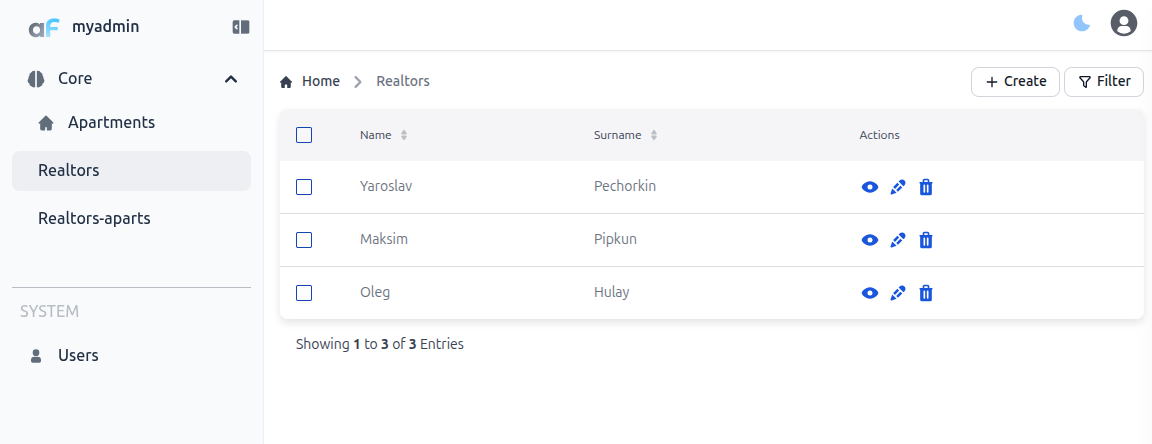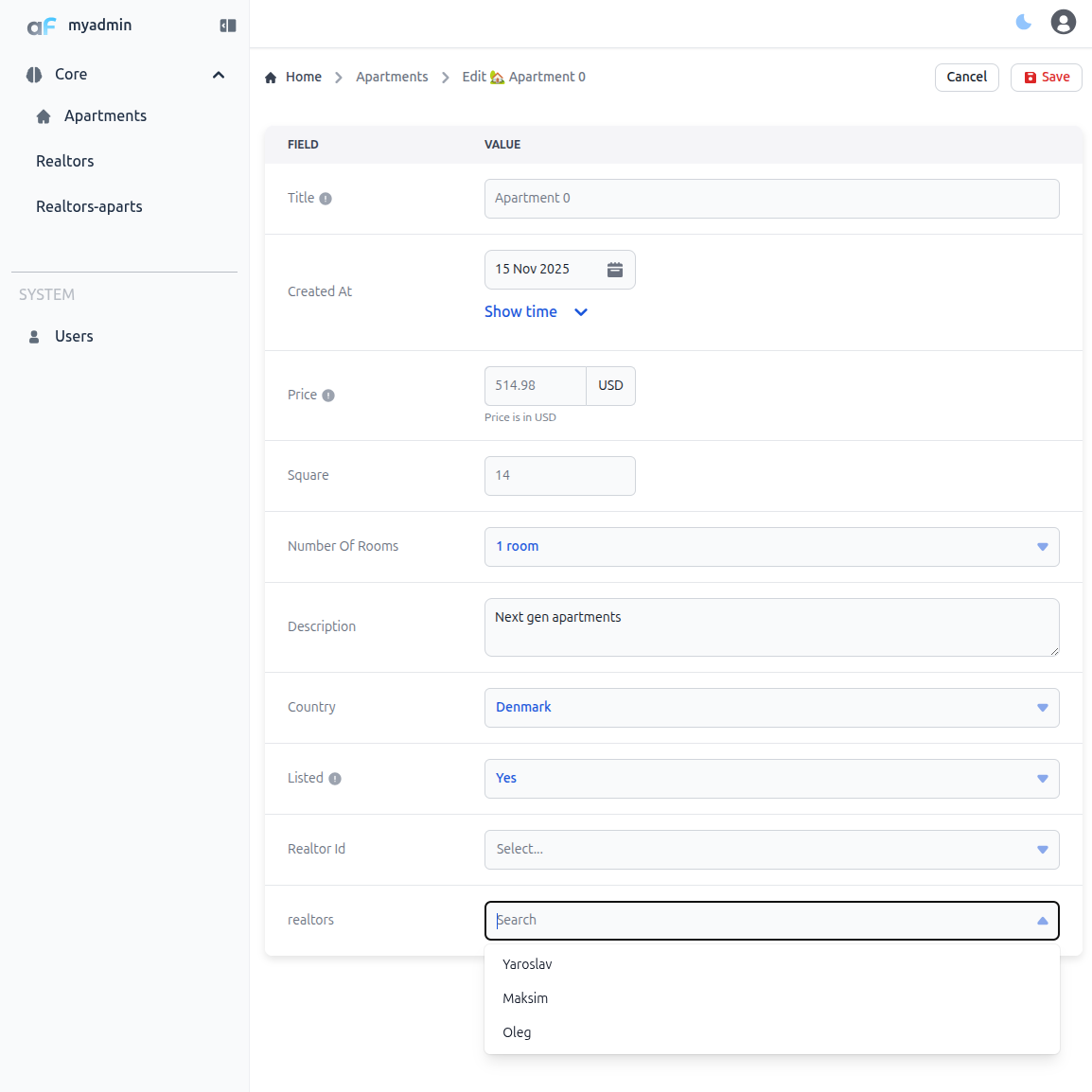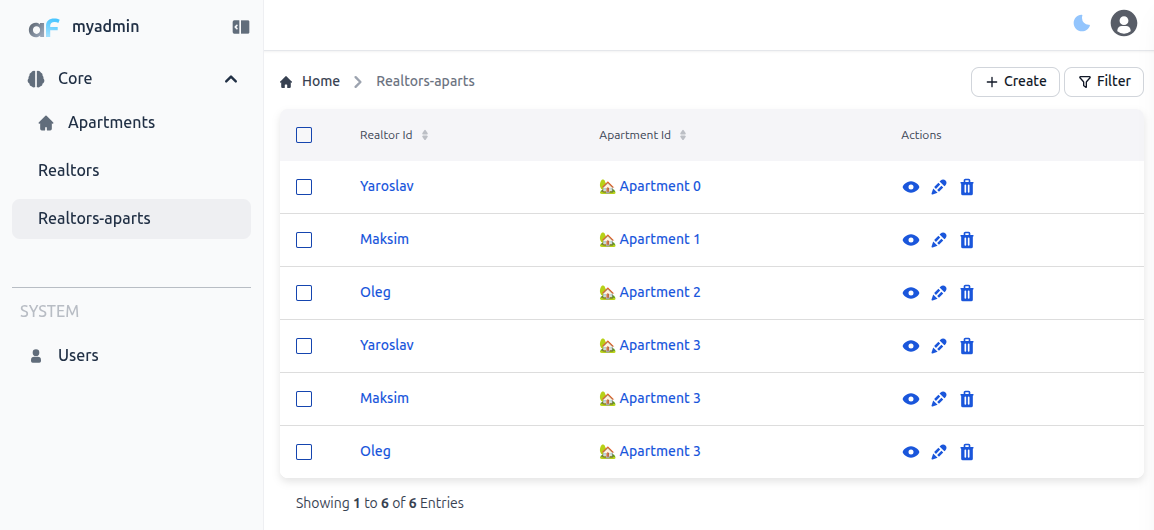Many2Many
This plugin lets you manage many-to-many relationships.
Installation
Install the plugin:
npm i @adminforth/many2many
Setting up
Let's say we want to implement a relationship where every apartment can have many realtors and each realtor can have many apartments. We'll also need a junction resource to connect realtors and apartments.
First, create the realtors table and the junction table realtorsAparts:
model realtors {
id String @id
name String
surname String
}
model realtorsAparts {
id String @id
realtorId String
apartmentId String
}
Migrate the Prisma schema:
npm run makemigration -- --name add-realtors-and-realtorsAparts; npm run migrate:local
Now create a resource for the realtors:
import { AdminForthDataTypes, AdminForthResourceInput } from 'adminforth';
export default {
dataSource: 'maindb',
table: 'realtors',
resourceId: 'realtors',
label: 'Realtors',
recordLabel: (r) => ` ${r.name}`,
columns: [
{
name: 'id',
type: AdminForthDataTypes.STRING,
label: 'Identifier',
showIn: {
list: false,
edit: false,
create: false,
},
primaryKey: true,
fillOnCreate: ({ initialRecord, adminUser }) => Math.random().toString(36).substring(7),
},
{
name: 'name',
required: true,
showIn: { all: true },
type: AdminForthDataTypes.STRING,
maxLength: 255,
minLength: 3,
},
{
name: "surname",
required: true,
showIn: { all: true },
type: AdminForthDataTypes.STRING,
maxLength: 100,
minLength: 3,
}
],
options: {
listPageSize: 12,
allowedActions: {
edit: true,
delete: true,
show: true,
filter: true,
},
},
} as AdminForthResourceInput;
And one for the junction table realtorsAparts:
import { AdminForthDataTypes, AdminForthResourceInput } from 'adminforth';
export default {
dataSource: 'maindb',
table: 'realtorsAparts',
resourceId: 'realtorsAparts',
label: 'Realtors-aparts',
columns: [
{
name: 'id',
type: AdminForthDataTypes.STRING,
label: 'Identifier',
showIn: {
list: false,
edit: false,
create: false,
},
primaryKey: true,
fillOnCreate: ({ initialRecord, adminUser }) => Math.random().toString(36).substring(7),
},
{
name: 'realtorId',
foreignResource: {
resourceId: 'realtors',
searchableFields: ['name'],
searchIsCaseSensitive: true
}
},
{
name: 'apartmentId',
foreignResource: {
resourceId: 'aparts',
searchableFields: ['title'],
searchIsCaseSensitive: true
}
},
],
options: {
listPageSize: 12,
allowedActions: {
edit: true,
delete: true,
show: true,
filter: true,
},
},
} as AdminForthResourceInput;
Now add the plugin resources to the main config file:
import realtorsResource from './resources/realtors.js';
import realtorsApartsResource from './resources/realtorsAparts.js';
...
dataSources: [
{
id: 'maindb',
url: `${process.env.DATABASE_URL}`
},
],
resources: [
...
realtorsResource,
realtorsApartsResource
]
...
menu: [
...
{
label: 'Realtors',
resourceId: 'realtors'
},
{
label: 'Realtors-aparts',
resourceId: 'realtorsAparts'
},
...
]
Finally, add the plugin to the apartments resource:
import Many2ManyPlugin from '@adminforth/many2many';
...
plugins: [
...
new Many2ManyPlugin({
linkedResourceId: 'realtors',
})
...
]
...
The plugin is set up. Create some records in the realtors table:
 Now, when creating an apartment, you can select (link) one or more realtors.
Now, when creating an apartment, you can select (link) one or more realtors.
 After saving the record, rows in the junction table are created automatically:
After saving the record, rows in the junction table are created automatically:

Disable automatic cleanup of the junction table
By default, when you delete a realtor or an apartment, all related rows in the junction table are deleted automatically. To avoid this behavior, add:
...
new Many2ManyPlugin({
linkedResourceId: 'realtors',
dontDeleteJunctionRecords: true, // prevents automatic deletion of related junction rows
})
...